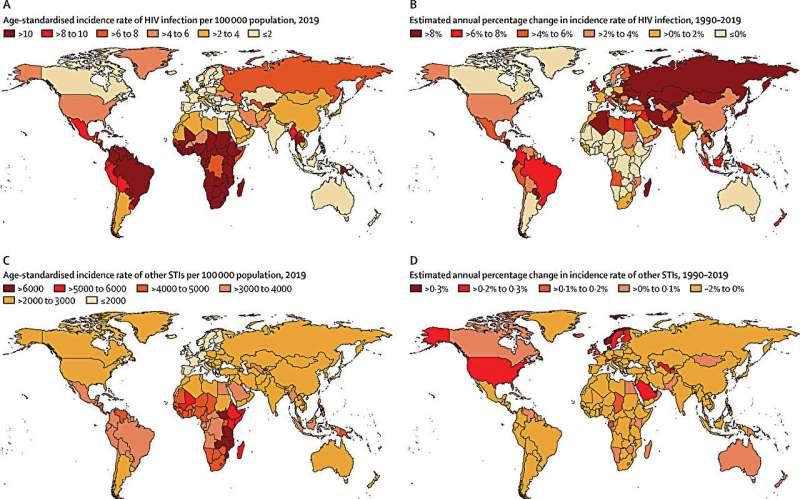This article has been reviewed according to Science X's editorial process and policies. Editors have highlighted the following attributes while ensuring the content's credibility:
fact-checked
trusted source
proofread
Sexually transmitted infections among older adults pose a global public health challenge, study says

The incidence of HIV and other STIs among people aged 60 to 89 years is increasing in some regions of the world. More awareness about the issue, stigma reduction and preventive measures are needed, according to a new study published in The Lancet Healthy Longevity.
People around the world live longer than ever before. The number of people above the age of 60 will almost double by 2050, according to WHO.
As we grow older, our health typically decreases. The immune system becomes weaker, and we become more susceptible to infections. This includes HIV and other sexually transmitted infections (STIs) such as syphilis, chlamydia, gonorrhea, trichomoniasis, and genital herpes.
"HIV and other STIs are equally prevalent in the sexually active older population as in the young population," says Evandro Fei Fang, Associate Professor at the Institute of Clinical Medicine at the University of Oslo.
"We need to pay attention to STIs in the older population," he continues.
Fang and colleagues have analyzed the global trends in the incidence, prevalence, mortality, and disability-adjusted life-years (DALYs) of HIV and other STIs, among older adults aged 60 to 89 years from 1990 to 2019 using data from 204 countries.
Increasing numbers of HIV and other STIs in some regions
Globally, the number of older adults with HIV and STIs has decreased over the last decades.
Even so, the number of new cases indicates that STIs in older adults continue to be a public health challenge. At the global level, there were more than 77,000 new cases of HIV and almost 26.5 million new cases of other STIs in older adults in 2019.
Furthermore, in some regions, the number of people who become infected is increasing.
"Despite the global decrease in the age-standardized incidence rate of HIV and other SITs in older adults from 1990 to 2019, many regions showed increases. The largest increases were in eastern Europe, central Asia, and high-income Asia Pacific," Fang explains. "This is a concerning trend."
Sexually active older adults often are more susceptible to HIV and other STIs than younger people. Various health conditions, especially the weakened immune system in older adults, can explain why.
However, the picture is more complex. Various biological, psychological, cultural, and societal factors contribute to the higher susceptibility.
Prevention programs often exclude older populations
Since we live longer and more of us get divorced, older adults more often than before get new partners. Even so, fewer in this age group use protective methods such as condoms and they are less likely to get tested for STIs.
"In general, there is a lot of attention on the prevention of HIV and other STIs in younger populations. Older individuals are often excluded from prevention programs," Fang explains.
Also, health care professionals are not always aware about sexuality and the sexual health of older adults.
This may lead to inadequate communication to older people regarding sexual health and the risk of HIV and other STIs.
On the other hand, advances in the treatment of HIV and STIs likely also contribute to a higher incidence in some parts of the world since people who have these conditions live longer than before.
Traveling to foreign countries has become more accessible to a considerable part of the world's population over the last decades.
The researchers describe that the widespread use of erectile dysfunction medications and accessible sex industries in some countries and regions, further contribute to the spread of HIV and other STIs among older adults.
Subtle increase of STIs among older adults in Norway
The study analyzed data for different countries and regions separately.
In Norway, HIV infections are very rare among older adults. Even so, the incidence of other STIs in this age group has subtly increased the last decades, from around 1,600 cases in 1990 to 1,700 cases in 2019.
"This is an early alarm to the general older population and the Norwegian public health authorities," Fang says.
Overall, the study shows that Norway is doing a good job in controlling HIV and STIs.
Fang has some recommendations for the Norwegian health authorities.
"The most important interventions are those focusing on education and awareness-raising among both health personnel and older adults about the issue. Addressing stigma and misconceptions is also central," he says.
"Health care providers could also collaborate with senior centers and relevant organizations to address the issue," Fang adds.
More information: Leiwen Fu et al, Global, regional, and national burden of HIV and other sexually transmitted infections in older adults aged 60–89 years from 1990 to 2019: results from the Global Burden of Disease Study 2019, The Lancet Healthy Longevity (2024). DOI: 10.1016/S2666-7568(23)00214-3



















